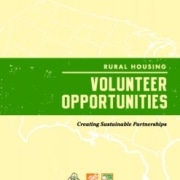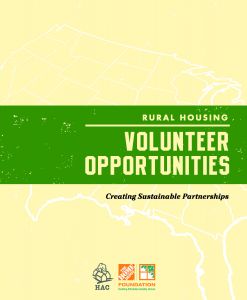| Housing for Persons with Disabilities in Rural Areas
INTRODUCTION
Since the 1970s, activists with disabilities have redefined the “problem” of physical challenges as one of disabling environments rather than “disabled” people. In 1990, the passage of the Americans with Disabilities Act (ADA), Title III, put this philosophy to work by requiring that places of public accommodation, commercial facilities and certain private facilities be made accessible to persons with disabilities – including housing.
Until recently, most publicity, program initiatives and funding for housing for persons with disability have been directed at cities. Likewise, research on accessible housing has tended to focus on urban areas, leaving little systematic information about the needs of persons with disabilities in rural areas. However, through the recent research by scholars on rural disability, the beginning of a rural accessible housing agenda has been established.
The ADA defines a person with a disability as someone who: a) has a physical or mental impairment that substantially limits one or more major life activities such as walking, seeing, hearing, or speaking; b) has a record of having such an impairment, whether or not the impairment still exists; or c) is regarded as having such an impairment, whether or not the perception is accurate. The definition also includes persons 60 years of age and older who are frail (have an inability to perform at least three activities of daily living without assistance, such as bathing, dressing or using the toilet). While advanced age, in and of itself, is not an impairment, various medical conditions commonly associated with age, such as hearing loss, osteoporosis, or arthritis, constitute disabilities.
LIVING WITH A DISABILITY IN RURAL AMERICA
Persons with disabilities in rural areas, like their urban counterparts, have a wide range of housing needs. Persons with physical disabilities need accessibility features to facilitate independent living. Persons with mental illness or persons requiring regular treatment/therapy for their condition need suitable access to a treatment facility. Frail elderly persons may require modifications to their existing homes. Others may prefer group housing or assisted living situations.
One fact of rural disability is that even though there are fewer persons with disabilities in nonmetro areas, they comprise a greater percentage of the population than in metropolitan counties. As the chart below demonstrates, while persons with disabilities make up 18 percent of the metropolitan population, they make up 23 percent of nonmetro areas; consequently, the demand for accessible living and working facilities is proportionally greater in nonmetro areas.
Source: U.S. Census, 1990
However, while the demand for accessible housing is higher in nonmetro areas, meeting that demand is also more difficult for the following reasons:
- Residents of rural areas tend to value independence, self-reliance and individualism.1 Although these are positive values, they also contribute to a reluctance to seek help from mental or physical health professionals among persons with disabilities in rural areas. This factor also makes it difficult to assess the need for accessible housing in rural areas.
- Transportation to health-related services is particularly problematic for rural people who may live hours from the nearest service center, clinic, hospital or day program. Nearly one-third of the 91 million people in nonmetro areas eligible for government transportation funding are transportation dependent, meaning that they have no personal transportation due to poverty (12.4 million), old age (12.1 million), and/or physical disability (11.9 million).2 Service providers must either deliver services where clients live, or arrange for rides or van pools to service sites, cutting into the time and funding available for direct services provision.
- Recruitment, training, and retention of health service providers in rural areas is hampered by professional and social isolation, lack of training opportunities and support, low wages, and high stress.
- Lack of basic infrastructure like municipal water and sewer services in rural areas often preclude the development of accessible housing, as well as limit the number of developers willing to work in these areas.
- Local zoning and land use restrictions often limit the siting of group homes in both urban and rural areas. These restrictions include dispersion requirements (prohibiting group homes from locating too close to one another), concentration requirements (prohibiting the location of group homes in certain areas), and occupancy requirements (limiting the number of residents).
PROGRAMS AND RESOURCES
Federal civil rights statutes protect persons with disabilities from discrimination in virtually all housing services and programs.
- Section 504 of the Rehabilitation Act of 1973 (Section 504).
Section 504 prohibits discrimination on the basis of disability or perceived disability in any program or activity that receives federal financial assistance, including all public and federally subsidized housing programs. Housing providers covered by Section 504 must bear the costs of making all programs accessible to and usable by persons with disabilities.
- The Fair Housing Amendments Act of 1988 (FHAA).
The FHAA extends protection against housing discrimination to persons with disabilities. It requires housing providers to permit, at the expense of the handicapped person, reasonable modifications of existing premises upon request. It also requires housing providers to make reasonable accommodations (adjustments to rules, policies, practices or procedures) upon request by handicapped persons. FHAA covers almost all housing activities or transactions in the public or private sector, including the discriminatory application of zoning, land use, or health and safety regulations.
- The Americans with Disabilities Act of 1990 (ADA).
ADA builds on the other statutes by prohibiting discrimination against persons with disabilities in private sector employment, all public services, public accommodations, transportation and telecommunications.
As in urban areas, implementation of these statutes in rural areas is fraught with difficulties such as residents’ unawareness of their rights and housing providers’ ignorance of the law, lack of affordable legal recourse, and persistence of restrictive local land use and zoning regulations.
In addition to generally-available low-income housing grant and loan programs (such as the Section 502 Direct and Guaranteed Loan Programs), there are a few programs and resources that address the housing needs of persons with disabilities in rural areas.3 The Section 811 Supportive Housing Program for Persons with Disabilities administered by the U.S. Department of Housing and Urban Development (HUD) is one example. The USDA/Rural Housing Service (RHS) also offers the Section 504 Home Repair Loan and Grant Program, which provides funds to modify homes for accessibility. The USDA/RHS also has a subsection of the Section 515 Rural Rental Housing Program that provides direct mortgage loans for the development of congregate housing or group homes for persons with disabilities.
Other federal programs, while not focused on serving the needs of persons with disabilities in rural areas, can also provide significant support. These include the McKinney-Vento Act homeless assistance programs, Community Services Block Grants allocated to states by the Department of Health and Human Services (DHHS), and housing programs administered by the Department of Agriculture’s Rural Housing Service (RHS).
Despite myriad challenges, there are several organizational resources available to assist rural persons with disabilities in securing affordable and accessible housing:
The Center for Assistive Technology (CAT/UB) 515 Kimball Tower, SUNY Buffalo Buffalo, NY 14214-3079 800-628-2281 (TTY)
National Council on the Aging, Inc. National Institute of Senior Housing 600 Maryland Ave., SW, West Wing 100 Washington, DC 20024 202-479-1200
Research and Training Center on Rural Rehabilitation Services 52 Corbin Hall, The University of Montana Missoula, MT 59812 406-243-5467 (voice/TTY) 888-268-2743 (toll free) https://ruralinstitute.umt.edu
FOOTNOTES
1Mental Health and Rural America: 1980-1993. Washington, D.C.: Federal Office of Rural Health Policy
2Spas, Diana and Tom Seekins. 1998. RURALfacts: Transportation. Missoula, MT: Research and Training Center on Rural Rehabilitation Services.
3RHS was formerly the Rural Housing and Community Development Service and before that the Farmers Home Administration. Additional information on RHS programs can be obtained from the Information Sheets on Rural Housing and Community Development Service Programs produced by the Housing Assistance Council. More information on HUD’s Section 811 program is available from the Information Sheet on Supportive Housing for Persons with Disabilities also produced by the Housing Assistance Council.
January 2001
This Information Sheet was prepared by the Housing Assistance Council. The work that provided the basis for this publication was supported by funding from the Ford Foundation and the U. S. Department of Housing and Urban Development. The substance and finding of that work are dedicated to the public. HAC is solely responsible for the accuracy of the statements and the interpretations contained in this publication and such interpretations do not necessarily reflect the views of the government.
|
|


 Rural Housing Volunteer Opportunities: Creating Sustainable Partnerships
Rural Housing Volunteer Opportunities: Creating Sustainable Partnerships